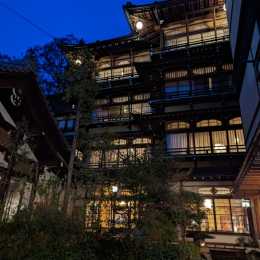The hot springs town of Shibu Onsen is both photogenic and sleepy. It’s been a popular place to visit for more than 1300 years, due in part to the numerous sources of thermal water here. The onsen town of Shibu Onsen has long been regarded as a place of refuge and healing, with both public and private bathhouses throughout. Shibu Onsen is arranged in a small valley, near the Yokoyugawa River in between the Jigokudani Monkey Park and the Yudanaka Onsen town (where the nearest railway stop is). There are traditional Japanese inns, and ryokans here, some dating back 400 years and like any onsen town there are yukata-clad visitors exploring the town and public onsen baths. Most people visit to see the Jigokudani Monkey Park, but it’s worth staying over and exploring. Here’s our guide to Shibu Onsen.
THIS POST MAY CONTAIN COMPENSATED AND AFFILIATE LINKS MORE INFORMATION IN OUR DISCLAIMER
One of the prime reasons to visit and stay overnight is that overnight guests get access to 8 of the public bathhouses that are only available to locals and overnight guests. If you’re just visiting for the day there is one bathhouse that you can pay for access and visit. Otherwise, the public bathhouses are locked and only accessible with a master key. And as it’s said that good fortune comes to those who visit all nine bathhouses, you will of course want to do this. A special towel is sold that allows you to collect stamps from each bathhouse, and it makes for a great souvenir of your visit to Shibu Onsen.
TOP RYOKAN
STAY AT A RYOKAN – make it the most famous one the Rekishi-no-Yado Kanaguya. The most famous ryokan in Shibu Onsen comes with Kaiseki Ryori meals, Japanese-style rooms, and 5 different private onsens, as well as rooms with private baths.
Why Visit Shibu Onsen
There’s something to be said for staying overnight in an onsen town. It’s a truly traditional Japanese experience. Multiple onsens mean that you’ll don your yukata, take your towel, and head to the various public onsens. Bathing is a serious business here. And here at Shibu Onsen, there are 9 public onsens, but you have to stay the night to get access to 8 of them!
This hot spring town is delightful, with small cobbled lanes, old-fashioned shops and of course the Jigokudani Monkey Park close by too. It’s a great place to visit at any time of year, regardless of whether there’s snow for the snow monkeys to play in.
PRACTICAL TRAVEL TIPS
- 🛡️ Get Travel Insurance: Civitatis includes medical expenses, repatriation, theft, luggage delays. No deductibles or upfront payments. Get a quote here.
- 💰 Read about the Currency in Japan and ATM fees.
- 🔌 Check out Japan’s plug, socket & power situation.
- 📶 Internet, maps, and data on the go. eSims for Japan
Things to do in Shibu Onsen
This sleepy little town is perfect to explore at a slower pace. It’s a great place for some downtime while also taking in some truly Japanese experiences. And we’re talking bucket list experiences. There’s staying in a ryokan, experiencing an onsen town, complete with yukata, geta sandals, and public bathhouses, and paying a visit to the snow monkeys of the Jigokudani Monkey Park.
Visit the Snow Monkeys of Jigokudani Monkey Park
For most visitors to Shibu Onsen, this is the reason for the stay. To visit the Jigokudani Monkey Park and the snow monkeys who frequent it. They’ve been famous in the area since the 1950s and even more so since they graced the front of Life Magazine in 1970! It’s an easy 30-minute walk to the entranceway of the Jigokudani Monkey Park, or you can take a local bus.
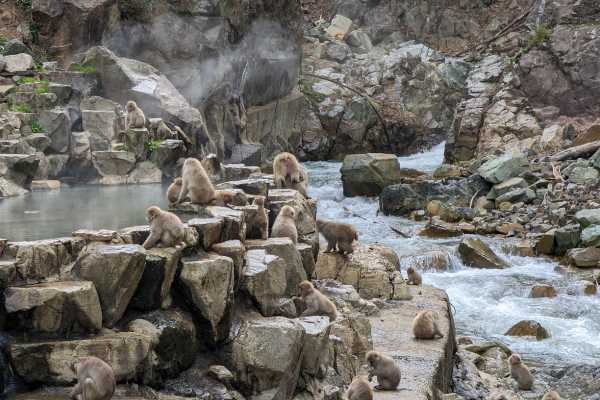
The park is open from 09:00 until 16:00 from November to March and then from 08:30 to 17:00 at other times of the year. My guide to the Jigokudani Monkey Park is here. The best time to visit is from 10:00 until about 14:30 when feeding takes place. There are great walks on either side of the river to get to and from the park.
Visit the 9 Onsens of Shibu Onsen
We’ve stayed in onsen towns before in Japan and they are magical. Sure they get day visitors, but the magic happens after the day trippers have gone home, when you get to experience the stillness and the silence of the town with no one else around. And with 9 public onsens in Shibu Onsen, you’re going to want to take the time to explore them all. You might, even, as we did, need to spend more than one night exploring them!

I’ve written about the public onsens of Shibu Onsen here xxxx, but here are the highlights. First of all, there’s a more than 1300-year history of visitors coming here to “take the waters”. Each of the different bathhouses is only available to residents and overnight guests and the bathhouses are locked, you only get access with a master key. (there is only one bathhouse that you can visit as a day visitor, and you can buy tickets from the Tourist information office in town).
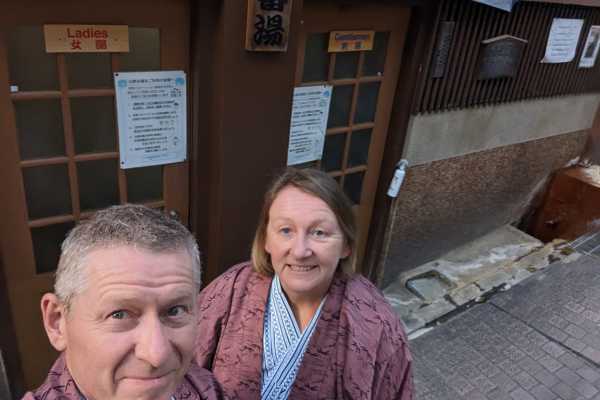
The thermal water in these different bathhouses comes from different spring sources and have a variety of benefits, so you can visit a specific bathhouse if you have specific ailments. You’ll want to buy a “tenugui” – a towel with the names of all the different onsens, and then as you hop from one onsen to another, stamp the tenugui. I’ve written about onsen etiquette and onsen rules in Japan here.
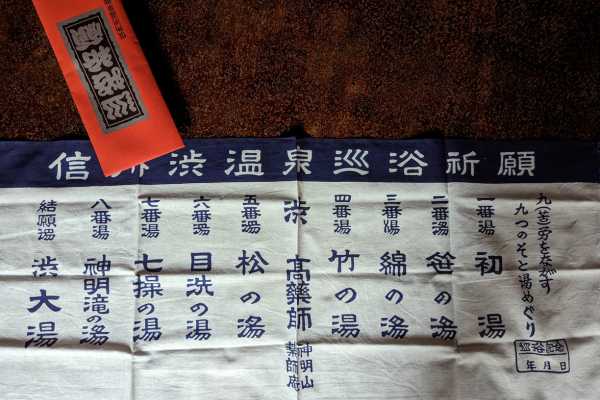
Collect all 9 stamps and you’ll attain good fortune and long life. Apparently. To ensure you long life and good fortune you’ll want to visit the temple above the town, the Shibu Takayakushi after you’ve collected all the stamps from the individual onsens.
Explore the narrow streets of Shibu Onsen.
This is the type of place where you’ll enjoy just wandering around. It’s quiet. And the architecture is interesting. But it also means that you’ll discover a specialty of the area, the onsen-steamed egg. Pick one up from outside the stores for ¥50 and enjoy a freshly – and naturally – boiled egg! Rest your feet too in the foot bath in town, and enjoy the healing (and warming) properties of the free thermal waters!
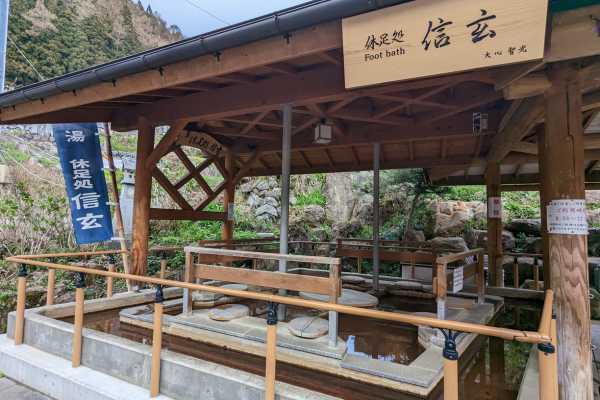
Go for a Hike from Shibu Onsen
This area, the Shiga Kogen area, has a series of fabulous hikes. And to be honest, if all you do is walk up one side of the river towards the Jigokudani Monkey Park, and back down again, then it’s a glorious place to walk.

Although this is going to depend on what time of year you visit. There are unlikely to be public facilities available after the end of October and before the beginning of April, especially in the higher country. Probably the best hike to try is the Ikemeguri Pond Loop.
Visit the Tamamura sake brewery in Yamanouchi Town.
It’s just a 7-minute walk from Shibu Onsen to this sake brewery that was established in 1805! It’s small and makes great sake. The sake brewery also began making its own beer in 2004, it’s named after the highlands of the Shiga Kogen and it also now hosts the annual Snow Monkey Beer Live festival. This happens during March and a variety of craft breweries get together and show off their latest developments. If you like sake, then you’re going to want to read about the Saijo Sake Town.
Essentials for Visiting Shibu Onsen
Most people just drive through Shibu Onsen on their way to the Jigokudani Monkey Park, but there are some very valid reasons for staying over. I’ll pick two of them for now. The first is to experience the onsens in town. There are onsens in Shibu Onsen, but 8 of them can only be visited if you’re staying in town. That’s number one. The second reason is to stay in a ryokan because there is something magical about staying in a ryokan in Japan and in an onsen town it’s even better.
We’ve stayed at several Ryokans and in several onsen towns. Read about our experiences in Kinosaki Onsen town, where we visited during a typhoon.
Where to Stay in Shibu Onsen
There are lots of hotels and guest houses in Shibu Onsen, but I do recommend staying in a traditional ryokan, it will seriously add to your experience. My guide to staying in Ryokans is here. And I recommend that you read it if you’re even the slightest bit concerned about staying in a ryokan. Or even if you’re not concerned, it tells you everything to expect from your stay.
I’ve written about the best ryokans to stay at in Shibu Onsen here, but for now, I’ll cover two of them. The first is the most famous ryokan in Shibu Onsen – Kanaguya. It’s said that the bathhouse here inspired the bathhouse in the Spirited Away movie from Studio Ghibli.
Kanaguya Ryokan – Shibu Onsen
This glorious ryokan in Shibu Onsen was recognized as a Registered Tangible Cultural Property in 2003 and is a once-in-a-lifetime experience that will take you back to the 1930s. At the Kanaguya there is a free 30-minute tour of the property before dinner which is well worth it to learn about the ryokan and the area. Don’t miss the Kaiseki Ryori dinner!

There are outdoor and indoor onsen facilities at the ryokan and you’re provided with a yukata and a key for exploring the 9 public onsens in town too. It’s a masterpiece of design and the top place to stay in Shibu Onsen. You can check rates and availability here.
Daymaruya Ryokan – Shibu Onsen
This glorious small ryokan has fabulous traditional rooms, and super onsen facilities (the outdoor one is magical and so private! It’s worth staying here for this alone. The owners are extremely friendly and couldn’t do enough for us, including offering lifts to and from the train station and giving advice on where to go, and what to eat in town. It’s fabulous. I recommend Daymayura highly!
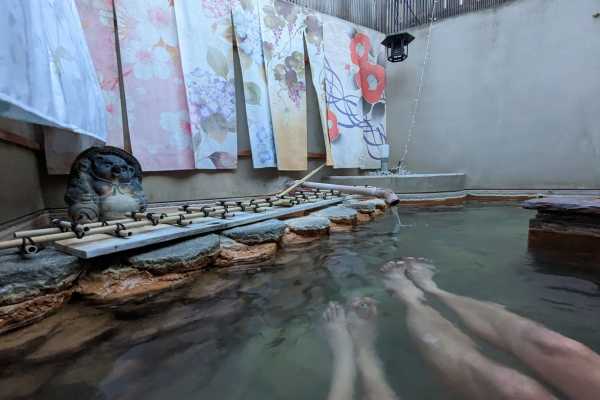
The yukata provided are fabulous, and of course, you get a key to the public onsens in town too. Check availability and book your stay here.
How to Get to Shibu Onsen
The largest hub city to Shibu Onsen is Nagano, so you’ll first want to get to Nagano, and then plan onward travel from there. You can take buses from Nagano to Shibu Onsen, or trains. The closest train station to Shibu Onsen is Yudanaka, and this line, the Nagano-Dentetsu line is a private line and is not covered on the JR Pass, so you have to buy tickets for it separately.
I’ve covered the main details on how to get to Nagano, and then afterward how to get from Nagano to Shibu Onsen.
Tokyo to Nagano
From Tokyo, you’ll want the Hokuriku Shinkansen to Nagano, which takes about 90 minutes. You can use your JR Pass for this journey or buy tickets separately (Klook is the best option).
Kyoto to Nagano
From Kyoto, you’ll need to change at least once to get to Nagano and then onto Shibu Onsen. The best option is to travel from Kyoto to Nagoya and then from Nagoya to Nagano. You can buy tickets from Kyoto to Nagano here.
Osaka to Nagano
From Shin Osaka, the slightly less than an hour Shinkansen to Nagoya Station and then transfer to the JR Shinano Limited Express, which takes you to Nagano. Get tickets for these trains here, on Klook, or they’re covered on your JR Pass.
Nagano to Yudanaka to Shibu Onsen
From Nagano train station you can take either a bus or a train to the closest train station to Shibu Onsen, which is Yudanaka. Both the bus and the train are run by the Snow Monkey Resort Company. And the train is NOT covered on the JR Pass.
You can buy tickets for this train (it’s called the Snow Monkey Express) at the dedicated ticket machines at Nagano railway station. Most people who visit Shibu Onsen are heading directly to the Jigokudani Monkey Park. This train takes you into Yudanaka, the closest train station to Shibu Onsen and the snow monkey park.
The express bus from Nagano Station (stop 23) is also run by the Snow Monkey Express Company and goes directly to the Snow Monkey Park, which is about a 20-30 minute walk (downhill) to Shibu Onsen.
If you are staying the night in Shibu Onsen then your ryokan or hotel will offer to pick you up but if you prefer to walk it’s an easy, if slightly uphill 30-minute walk alongside quiet roads.
Yudanaka Station to Shibu Onsen
The closest train station to the Snow Monkey Park is Yudanaka station, where the Snow Monkey Express train comes in. It’s just a short walk into Shibu Onsen from here, but it is slightly uphill. You can also get taxis or take the local bus, but if you’re staying overnight, then your ryokan or hotel will offer to collect you.
The local bus timetable is displayed outside the train station and you can find the current timetable here. The bus takes about 7 minutes to go from Yudanaka Station to Shibu Onsen.
Where & What to Eat in Shibu Onsen
If you’re staying at a ryokan in Shibu Onsen, then I recommend partaking of the Kaiseki Ryori food options that they have. Having your meals in your ryokan room is a fabulous part of the ryokan experience in Japan. DO NOT MISS IT. Read about Kaiseki Ryori here.
Try the onsen eggs – hot boiled eggs that are cooked in the hot thermal waters outside some of the stores in town. They’re really good!

Izakaya Chokkin, Shibu Onsen
This place is legendary. The menu is what the owner/chef wants to cook. And it was all good. You’ll drink a lot of beer or sake in here, it’s just that kind of place. And yes you can visit the onsens and come in wearing your yukata. It’s really informal, great fun and if you’re lucky you’ll have your photo taken which the owner then pins on to the ceiling. Then you know you’ve made it (or spent enough money!!)

The sign outside says “cheap beer, cheap food, funny owner” and its 100% right. Don’t miss it.
How Long to Spend in Shibu Onsen
If you’re visiting the snow monkeys at the Jigokudani Monkey Park, then you’ll want to spend at least one night here. I recommend spending two nights here, that will give you time to explore the town, the monkey park, and the onsens. If you want to visit all 9 public onsens that you get access to by staying overnight, then two nights will get you into all of them without feeling that you just take off your yukata, jump in the hot water, and then jump out again.
JAPAN TRAVEL RESOURCES
TRAIN TICKETS
Easiest way to buy train tickets, use Klook for Shinkansen Train Tickets, check timetables & reserve seats.
Book Train Tickets
HOTELS AND APARTMENTS
See choices here
Sea view rooms? Budget rooms? Need a washing machine? The best choice of hotels & apartments.
TOURS & ATTRACTIONS
Most excursion choices, small group tours, skip-line tickets, free cancellation and top local guides.
Top options here.
CAR RENTAL GUIDE
Read my Guide
Best choice of vehicles, automatics, large or small cars, child seats. Book early for more options.
Final Words on Our Guide to Shibu Onsen, Nagano
Shibu Onsen has a long history of welcoming visitors to this area, famous for its hot springs and thermal waters. Many have come over the centuries for the healing powers of the waters. For us, Shibu Onsen was a delight – a quiet, but fun experience. The onsens here are great and very different from what you’ll experience in other onsen towns, the area around the town is gloriously rural and peaceful and of course, you’ll get to see the snow monkeys at Jigokudani Monkey Park too.
ASocialNomad is a participant in the Amazon Services LLC Associates Program, an affiliate advertising program designed to provide a means for sites to earn advertising fees by advertising and linking to amazon.com, amazon.co.uk, and amazon.ca. Amazon and the Amazon logo are trademarks of Amazon.com, Inc. or its affiliates. As an Amazon Associate, I earn from qualifying purchases.
